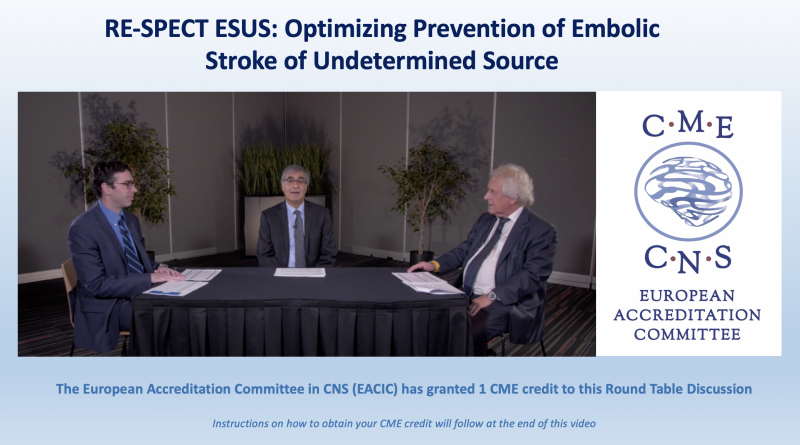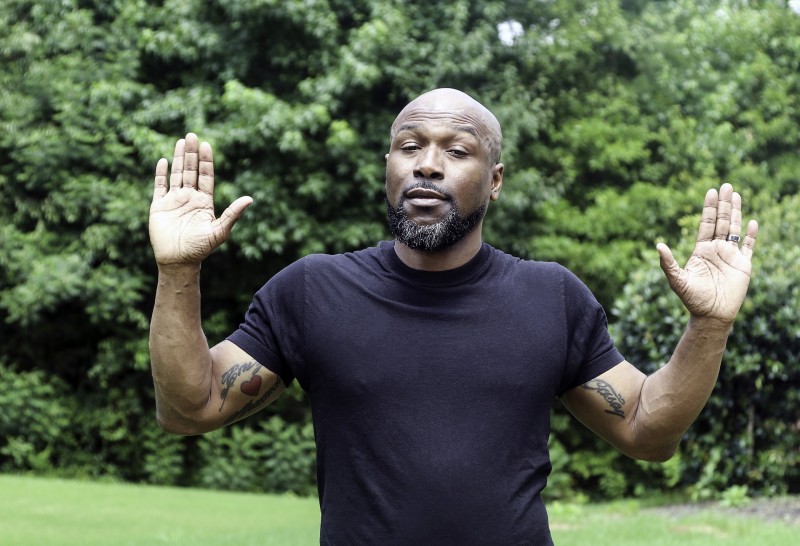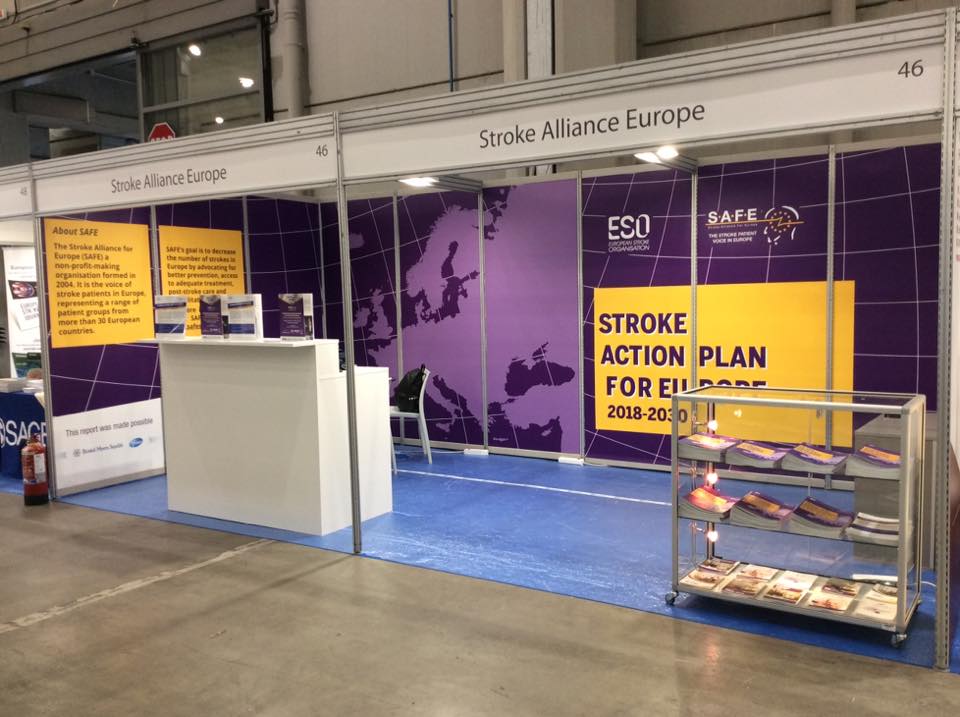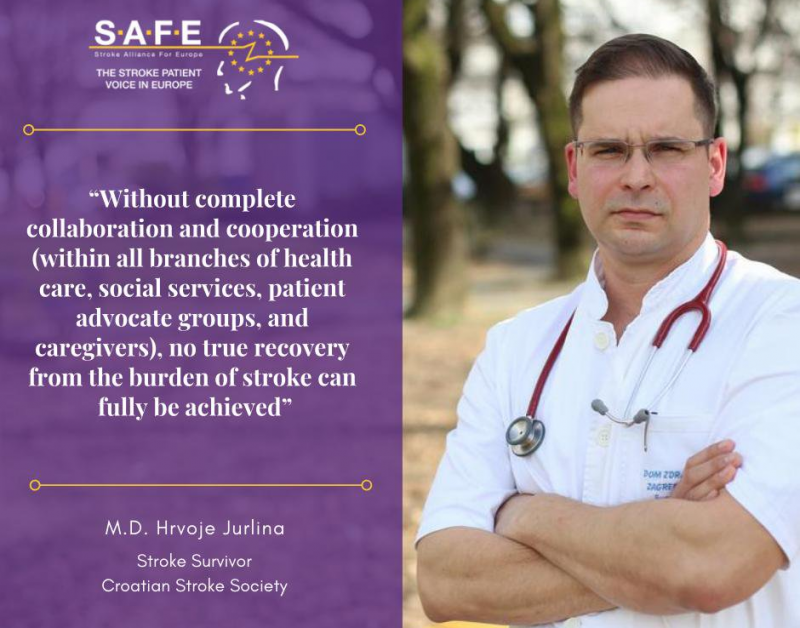
May 30, 2019
We would like to recommend to your attention a Round-Table discussion that held place at last year’s WSC in Montreal, Canada.
This Round Table Discussion reviews strategies for secondary prevention strategies in ESUS and the implications of the recent RE-SPECT ESUS results for clinical practice.
Following completion of this activity, learners will be able to:
- Describe RE-SPECT ESUS clinical trial results
- Outline the benefits and risks of NOACs in ESUS
- Discuss the implications of RE-SPECT ESUS for clinical practice
RE-SPECT ESUS: Optimizing Prevention of Embolic Stroke of Undetermined Source
Moderator:
Mike Sharma MD, MSc, Associate Professor, Division of Neurology, Department of Medicine, McMaster University, Ontario, Canada
Faculty:
Richard A. Bernstein MD, PhD, Professor of Neurology, Feinberg School of Medicine, Northwestern University, Illinois, USA
Hans-Christoph Diener MD, PhD, Professor of Neurology, University of Duisburg-Essen, Germany
Please click here to view video.

May 27, 2019
This article was first published on ScienceDaily.com
Although the occurrence of first-ever ischemic stroke (strokes due to a blood clot that blocks a blood vessel in the brain) at middle age has been decreasing over time, researchers have found that the decline is not as steep as seen in older adults.
The risk for stroke at midlife declined by approximately 39 percent, while risk of stroke at older age declined by 53 percent, when comparing a recent time period (1998-2005) to a previous time period (1962-67).
“Most strokes at midlife were due to diseases of the arteries (atherosclerosis) caused by a clot migrating from the heart. We also looked at vascular risk factors, such as hypertension and smoking, which have been declining among both age groups over time,” explained corresponding author Hugo J. Aparicio, MD, MPH, assistant professor of neurology at Boston University School of Medicine.
The researchers studied trends in the rate of ischemic stroke among two age groups in the Framingham Heart Study: middle age-35-55 years old and older age-above 55 years old. They estimated the rate of stroke occurring in four time periods, 1962-67, 1971-76, 1987-1991 and 1998-2005. They also looked at risk for stroke calculated using the Framingham Stroke Risk Profile, which gives an estimate for how likely a stroke will occur over the ensuing 10 years.
You can read the full article here.
Image source: Pixabay.com

May 25, 2019
The 5th European Stroke Organisation Conference (ESOC), took place in Milan, Italy, from 22 to 24 May 2019.
ESOC 2019 was attended by more than 5,600 participants from all over the world. Stroke Alliance for Europe had a stand at this important event, providing information on the latest stroke advocacy activities.
One of the highlights of ESOC 2019 was the constitution of the Steering Committee for the “Stroke Action Plan for Europe 2018-2030” implementation, in which SAFE will take active participation, representing the voice of stroke patients from 33 European countries.
SAFE promoted the Stroke Action Plan on its stand, now available in additional seven European languages (French, Polish, Spanish, Portuguese, Russian, Ukrainian and Greek) with many more translations to come. The Stroke Action Plan’s translation will increase its reach throughout Europe and significantly help stroke support organisations in with their further advocacy work.
Two of the SAFE Board members, Anita Arsovska from North Macedonia and Hariklia Proios from Greece held important lectures as part of ESOC Scientific Programme. SAFE’s President, Jon Barrick, co-chaired a session on the last days of the congress, covering the topic of the burden of stroke in Europe and the Life After Stroke issues.
Apart from the Board members, other SAFE organisations’ members from Turkey, Italy, Croatia, Hungary, Portugal and many other countries took active part in the ESOC 2019 programme within their fields of expertise.
Video credits: Turkish Stroke Support Organisation BEYINDER.

May 24, 2019
“For stroke survivors the real battle begins after they have been discharged from the hospital. The bio-psycho-social burden on any society (family unit), if they are not properly prepared or organized, can very quickly become devastating” said Hrvoje Jurlina, M.D., stroke survivor from Croatian Stroke Society.
SAFE: What is one issue related to the life after stroke in your country that you think needs special attention?
HJ: As in every country the healthcare system has its flaws. The root to a great percentage of these imperfections within the healthcare system lies in the lack of logistical coordination within the system itself. For example: ”If a bus driver does not know his own bus root how can anyone on board the bus be expected to arrive successfully to their desired destination?” (The Bus symbolizes Stroke, the bus driver represents the healthcare system, the bus route substitute as ‘Life after Stroke’, the bus stops depict the specific levels of care, therapy, and rehabilitation the stroke survivor must go through, and the desired destination of the stroke survivor within that bus route represents the desired level of recovery from the burden of stroke.) This is very much so the situation in many healthcare systems in regards to stroke patients. Once the stroke survivor is released from the hospital , the stroke survivor and their primary caregiver (”get on that bus”) are given very little if any information regarding post hospital recovery procedures and care options. The information given is most often very superficial and lacks a realistic picture of what awaits the stroke survivor and their primary caregiver in the immediate and distant future.
SAFE: What would be the solution, i.e. what is your organisation’s position regarding this issue?
HJ: The need for some form of standardized criteria regarding recovery, care options as well as an insight into patient rights for stroke survivors and their primary caregivers is thoroughly needed. ‘ The bus route must be laid out, all of the bus stops must be clearly marked so that the stroke survivor as well as their primary caregiver may successfully navigate and reach their desired destination, which is the recovery from the burden of stroke. To achieve these goals a firm foundation must be put in place in which an alliance of all parties involved in the stroke survivors rehabilitation and recovery can come together in order to maximize a successful post stroke outcome. Without complete collaboration and cooperation (within all branches of health care, social services, patient advocate groups, and the stroke survivors primary caregiver) no true recovery from the burden of stroke can fully be achieved. This continuous burden not only inhibits all aspects of the stroke survivors life but directly influences the lives of their family members and society as a whole.
SAFE: Please tell us more about your organisation.
HJ: Croatian Stroke Society (Hrvatsko društvo za prevenciju moždanog udara) was founded in 1997 with the aim to prevent stroke among persons at risk and stroke survivors, and to improve diagnostics, treatment and rehabilitation, based on the latest scientific knowledge. Raising the stroke awareness in Croatia, which will lead to the reduction of stroke by creating a healthier and more conscious society, is our vision. The Croatian Stroke Society is divided into two branches which are collaborating – stroke survivors section and professional/scientific section. Our activities are focused at educating the population, stroke survivors, caregivers and the medical staff about stroke to improve diagnosis, treatment and rehabilitation. The stroke survivors section members are primarily involved on raising the stoke awareness among the population including stroke survivors and their family and caregivers organizing public campaigns, patient groups, lectures with stroke risk assessments, activities on social media channels, etc. The professional/scientific section members are primarily involved on raising the stroke awareness and education of health professionals as well as providing the medical scientific background to the public and stroke survivors. Croatian Stroke Society is proud member of the Stroke Alliance for Europe, European Stroke Organization and Central and Eastern European Stroke Society.

May 20, 2019
This article was first published on ScienceDaily.com
A new study from the University of Eastern Finland shows that a moderately high intake of dietary cholesterol or consumption of up to one egg per day is not associated with an elevated risk of stroke. Furthermore, no association was found in carriers of the APOE4 phenotype, which affects cholesterol metabolism and is remarkably common among the Finnish population. The findings were published in the American Journal of Clinical Nutrition.
Findings from earlier studies addressing the association of dietary cholesterol or egg intake with the risk of stroke have been contradictory. Some studies have found an association between high dietary cholesterol intake and an increased risk of stroke, while others have associated the consumption of eggs, which are high in cholesterol, with a reduced risk of stroke. For most people, dietary cholesterol plays a very small role in affecting their serum cholesterol levels. However, in carriers of the apolipoprotein E phenotype 4 — which significantly impacts cholesterol metabolism — the effect of dietary cholesterol on serum cholesterol levels is greater. In Finland, the prevalence of APOE4, which is a hereditary variant, is exceptionally high, with approximately one third of the population presenting as carriers. Yet, research data on the association between a high intake of dietary cholesterol and the risk of stroke in this population group has not been available until now.
The dietary habits of 1,950 men aged between 42 and 60 years with no baseline diagnosis of a cardiovascular disease were assessed at the onset the Kuopio Ischaemic Heart Disease Risk Factor Study, KIHD, in 1984-1989 at the University of Eastern Finland. APOE phenotype data were available for 1,015 of the men participating in the study. Of those, 32% were known carriers of APOE4.
During a follow-up of 21 years, 217 men were diagnosed with stroke. The study found that neither dietary cholesterol nor egg consumption was associated with the risk of stroke — not even in carriers of APOE4.
The findings suggest that moderate cholesterol intake or daily egg consumption are not associated with the risk of stroke, even in persons who are genetically predisposed to a greater effect of dietary cholesterol on serum cholesterol levels. In the highest control group, the study participants had an average daily dietary cholesterol intake of 520 mg and they consumed an average of one egg per day, which means that the findings cannot be generalised beyond these levels. One egg contains approximately 200 mg of cholesterol. In this study, about a fourth of the total dietary cholesterol consumed came from eggs. Furthermore, the generalisability of this study is also weakened by the fact that the study population did not have a pre-existing cardiovascular disease at baseline and the size of the study population was relatively small. Therefore, the findings of the study should be verified in a larger cohort as well as in people with a pre-existing cardiovascular disease, who are currently advised to limit their intake of cholesterol and eggs.
Story Source: University of Eastern Finland. “Dietary cholesterol or egg consumption do not increase the risk of stroke, Finnish study finds.” ScienceDaily. ScienceDaily, 20 May 2019. <www.sciencedaily.com/releases/2019/05/190520093448.htm>.









